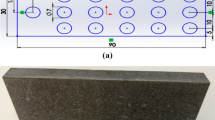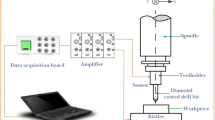Abstract
In this study, investigation of aluminum-silicon carbide (Al/SiC) with and without cryogenic treated drills has been performed. The influence of drill treatment condition coupled with processing parameters on machinability of Al/SiC was observed in terms of thrust forces, drill vibration and hole surface integrity. It was observed that the cryogenic treatment is suitable to enhance the machinability of Al/SiC as it does not alter the drill morphology and reduce various drilling related issues. Cryogenic treatment increased drill hardness and reduced thrust force and drill vibration. Vibration acceleration decreases from 110 m/sec2 to 98 m/sec2 and 92 m/sec2 at maximum feed rate, with 24 hrs and 48 hrs cryogenic treatment, respectively. The reduction in drilling vibrations was the influential parameters that reduced drill diameter, delamination and surface roughness of the workpiece. Surface roughness was improved from Ra 1.96 µm to 1.7 µm at maximum feed rate with 24 hrs and 48 hrs cryogenic treatment, respectively.
Similar content being viewed by others
Abbreviations
- Al/SiC :
-
Aluminum silicon carbide
- MMC :
-
Metal matrix composite
- WEDM :
-
Wire cut electrical discharge machine
- UTD :
-
Untreated drill
- 24-hrs CTD :
-
24 hours cryogenically treated drill
- 48-hrs CTD :
-
48 hours cryogenically treated drill
- hrs :
-
Hours
- °C :
-
Degree celsius
- n :
-
Spindle speed
- rpm :
-
Revolution per minute
- f :
-
Feed rate
- mm/rev :
-
Millimeter per revolution
- Kgf :
-
Kilogram force
- N :
-
Newton
- XRD :
-
X-ray diffraction
- F d :
-
Delamination factor
- D max :
-
Maximum diameter
- D o :
-
Original diameter
- Dia :
-
Diameter
- F z :
-
Thrust force
- a x :
-
Vibration acceleration
- Ra :
-
Surface roughness
- SEM :
-
Scanning electron microscopy
References
S. Suresh, A. Mortensen and A. Needleman, Fundamentals of Metal Matrix Composites, Elsevier Inc. (1993).
S. Durante, G. Rutelli and F. Rabezzana, Aluminum-based MMC machining with diamond-coated cutting tools, Surf. Coatings Technol., 94 (1997) 632–640.
J. W. Kaczmar, K. Pietrzak and W. Wtosiński, The production and application of metal matrix composite materials, J. Mater Process Technol., 106 (2000) 58–67.
S. Kumar, R. Singh and M. S. J. Hashmi, Metal matrix composite: A methodological review, Adv. Mater. Process Technol., 6 (2020) 13–24.
S. Waqar, Y. He, C. A. Abbas and A. Majeed, Optimization of cutting tool geometric parameters in milling of CFRP laminates, 21st International Conferences on Composite Materials, **an, China (2017).
G. Zhou, C. Xu and Y. Ma, Prediction and control of surface roughness for the milling of Al/SiC metal matrix composites based on neural networks, Adv. Manuf., 8 (2020) 486–507.
A. K. Sahoo and S. Pradhan, Modeling and optimization of Al/SiCp MMC machining using Taguchi approach, Measurement, 46 (2013) 3064–3072.
J. L. Thorogood, Automation in drilling: future evolution and lessons from aviation, SPE Drill Complet, 28 (2013) 194–202.
D. Chen, P. Yuan and T. Wang, A compensation method for enhancing aviation drilling robot accuracy based on co-kriging, Int. J. Precis Eng. Manuf., 19 (2018) 1133–1142.
P. Rahme, Y. Landon and F. Lachaud, Drilling of thick composite material with a small-diameter twist drill, Int. J. Adv. Manuf. Technol., 76 (2015) 1543–1553.
S. Waqar, S. Asad, S. Ahmad and Ch. A. Abbas, Effect of drilling parameters on hole quality of Ti-6Al-4V titanium alloy in dry drilling, Materials Science Forum, 880 (2016) 33–36.
J. P. Davim, Study of drilling metal-matrix composites based on the Taguchi techniques, J. Mater. Process Technol., 132 (2003) 250–254.
G. Tosun and M. Muratoglu, The drilling of an Al/SiCp metal-matrix composites, part I: microstructure, Compos. Sci. Technol., 64 (2004) 299–308.
G. Tosun and M. Muratoglu, The drilling of Al/SiCp metal-matrix composites, part II: workpiece surface integrity, Compos Sci. Technol., 64 (2004) 1413–1418.
T. Rajmohan and K. Palanikumar, Application of the central composite design in optimization of machining parameters in drilling hybrid metal matrix composites, Measurement, 46 (2013) 1470–1481.
M. Jamshidinia, M. M. Atabaki and M. Zahiri, Microstructural modification of Ti-6Al-4V by using an in-situ printed heat sink in electron beam melting®(EBM), J. Mater. Process Technol., 226 (2015) 264–271.
V. N. Gaitonde, S. R. Karnik and J. P. Davim, Some studies in metal matrix composites machining using response surface methodology, J. Reinf. Plast Compos., 28 (2009) 2445–2457.
T. Rajmohan, K. Palanikumar and J. P. Davim, Analysis of T. Rajmohan, K. Palanikumar and J. P. Davim, Analysis of surface integrity in drilling metal matrix and hybrid metal matrix composites, J. Mater. Sci. Technol., 28 (2012) 761–768.
A. R. Ahamed, P. Asokan, S. Aravindan and M. K. Prakash, Drilling of hybrid Al-5 % SiCp-5 % B4Cp metal matrix composites, Int. J. Adv. Manuf. Technol., 49 (2010) 871–877.
S. Basavarajappa, G. Chandramohan and J. P. Davim, Drilling of hybrid aluminium matrix composites, Int. J. Adv. Manuf. Technol., 35 (2008) 1244–1250.
T. Rajmohan and K. Palanikumar, Experimental investigation and analysis of thrust force in drilling hybrid metal matrix composites by coated carbide drills, Mater Manuf. Process, 26 (2011) 961–968.
A. Y. L. Yong, K. H. W. Seah and M. Rahman, Performance evaluation of cryogenically treated tungsten carbide tools in turning, Int. J. Mach. Tools Manuf., 46 (2006) 2051–2056.
J. Y. Huang, Y. T. Zhu and X. Z. Liao, Microstructure of cryogenic treated M2 tool steel, Mater Sci. Eng. A, 339 (2003) 241–244.
S. Li, L. Deng, X. Wu and H. Wang, Influence of deep cryogenic treatment on microstructure and evaluation by internal friction of a tool steel, Cryogenics (Guildf), 50 (2010) 754–758.
A. Molinari, M. Pellizzari and S. Gialanella, Effect of deep cryogenic treatment on the mechanical properties of tool steels, J. Mater Process Technol., 118 (2001) 350–355.
S. S. Gill, J. Singh, H. Singh and R. Singh, Metallurgical and mechanical characteristics of cryogenically treated tungsten carbide (WC-Co), Int. J. Adv. Manuf. Technol., 58 (2012) 119–131.
A. M. Abrão, P. E. Faria and J. C. C. Rubio, Drilling of fiber reinforced plastics: A review, J. Mater Process Technol., 186 (2007) 1–7.
V. Sivalingam, J. Sun and B. Selvam, Experimental investigation of tool wear in cryogenically treated insert during end milling of hard Ti alloy, J. Brazilian Soc. Mech. Sci. Eng., 41 (2019) 110.
Acknowledgments
This work is financially supported by National Natural Science Foundation of China (52275464), Scientific Research Project for National High-level Innovative Talents of Hebei Province Full-time Introduction (2021HBQZYCXY004), and National Natural Science Foundation of China (52075300).
Author information
Authors and Affiliations
Corresponding author
Additional information
Ch Asad Abbas completed his Master’s degree from School of Mechanical Engineering, Shandong University, China. Currently, he is doing Ph.D. in Mechanical Manufacturing & Automation from Shandong University, **an, China. His research interest includes machining of difficult to cut materials and machining technology of novel materials etc.
Huang Chuanzhen is Professor and doctoral supervisor at School of Mechanical Engineering at Yanshan University and Shandong University, China. His research area includes high efficient and clean manufacturing, ultra-precision machining process and 3D-bioprinting and Advanced ceramic tool materials and structural ceramics.
Huma Hafeez did her bachelor degree in Mechatronics Engineering with Gold Medal in 2018 from UET Taxila, Pakistan. She completed her Master’s degree in Mechatronics Engineering from Shandong University, **an, China in 2021. Her research interest includes Image Processing, Deep Learning, Machine Vision and Artificial Intelligence.
Li Binghao is a Ph.D. student at School of Mechanical Engineering at Shandong University, China. His research interests are deep-hole machining process and surface modification technology.
Liu Hanlian is a Professor and doctoral supervisor at the school of mechanical engineering, Shandong University. Her research interests are research and development of high performance ceramic cutting tools and high-speed machining process.
Rights and permissions
About this article
Cite this article
Abbas, C.A., Chuanzhen, H., Hafeez, H. et al. Influence of cryogenic treatment duration of drills on drilling performance and hole quality of metal matrix composite materials. J Mech Sci Technol 37, 5081–5091 (2023). https://doi.org/10.1007/s12206-023-0913-8
Received:
Revised:
Accepted:
Published:
Issue Date:
DOI: https://doi.org/10.1007/s12206-023-0913-8




